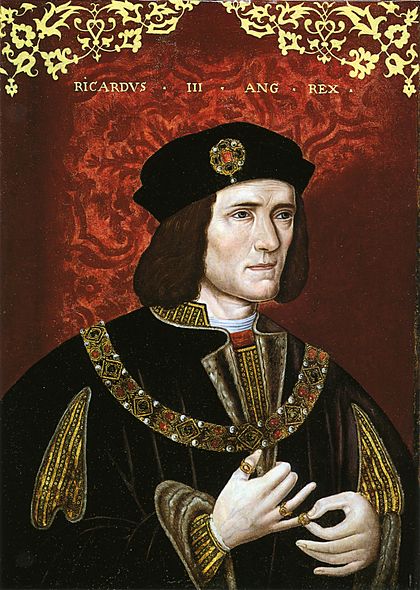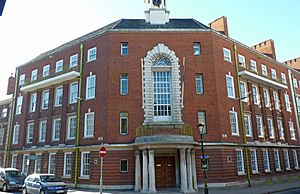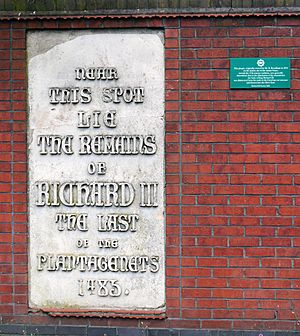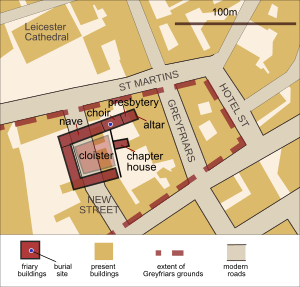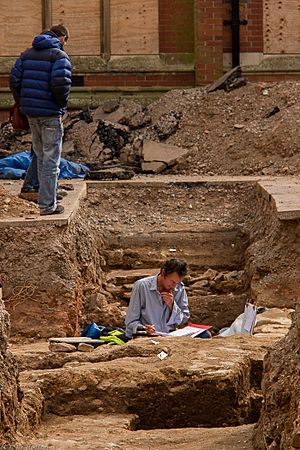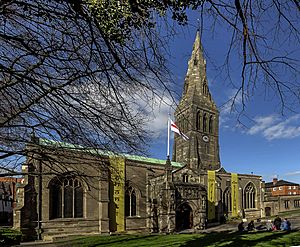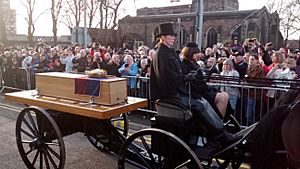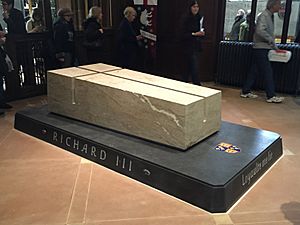Exhumation and reburial of Richard III of England facts for kids
The exhumation and reburial of Richard III of England began with the discovery of the king's remains within the site of the former Greyfriars Friary Church in Leicester, England, in September 2012. Following extensive anthropological and genetic testing, the remains of Richard III, the last English king killed in battle, were ultimately reinterred at Leicester Cathedral on 26 March 2015.
Richard III, the final ruler of the Plantagenet dynasty, was killed on 22 August 1485 in the Battle of Bosworth Field, the last significant battle of the Wars of the Roses. His body was taken to Greyfriars Friary in Leicester, where it was buried in a crude grave in the friary church. Following the friary's dissolution in 1538 and subsequent demolition, Richard's tomb was lost. An erroneous account arose that Richard's bones had been thrown into the River Soar at the nearby Bow Bridge.
A search for Richard's body began in August 2012, initiated by the Looking for Richard project with the support of the Richard III Society. The archaeological excavation was led by the University of Leicester Archaeological Services, working in partnership with Leicester City Council. On the first day a human skeleton belonging to a man in his thirties was uncovered showing signs of severe injuries. The skeleton, which had several unusual physical features, most notably scoliosis, a severe curvature of the back, was exhumed to allow scientific analysis.
The age of the bones at death matched that of Richard when he was killed; they were dated to about the period of his death and were mostly consistent with physical descriptions of the king. Preliminary DNA analysis showed that mitochondrial DNA extracted from the bones matched that of two matrilineal descendants, one 17th-generation and the other 19th-generation, of Richard's sister Anne of York. Taking these findings into account along with other historical, scientific and archaeological evidence, the University of Leicester announced on 4 February 2013 that it had concluded beyond reasonable doubt that the skeleton was that of Richard III.
As a condition of being allowed to disinter the skeleton, the archaeologists agreed that, if Richard were found, his remains would be reburied in Leicester Cathedral. A controversy arose as to whether an alternative reburial site, York Minster or Westminster Abbey, would be more suitable. A legal challenge confirmed there were no public law grounds for the courts to be involved in that decision. Reinterment took place in Leicester on 26 March 2015, during a televised memorial service held in the presence of the Archbishop of Canterbury and senior members of other Christian denominations.
Contents
Death and initial burial
Richard was killed fighting the forces of Henry Tudor at the Battle of Bosworth in 1485, the last major battle of the Wars of the Roses. The Welsh poet Guto'r Glyn credited Richard's death to Sir Rhys ap Thomas, a Welsh member of Henry's army who was said to have struck the fatal blow. Following his death, Richard's body was stripped naked and taken to Leicester where it was put on public display. The anonymous Ballad of Bosworth Field says that "in Newarke laid was hee, that many a one might looke on him" —almost certainly a reference to the collegiate Church of the Annunciation of Our Lady of the Newarke, a Lancastrian foundation on the outskirts of medieval Leicester. According to the chronicler Polydore Vergil, Henry VII "tarried for two days" in Leicester before leaving for London, and on the same date as Henry's departure—25 August 1485—Richard's body was buried "at the convent of Franciscan monks [sic] in Leicester" with "no funeral solemnity". The Warwickshire priest and antiquary John Rous, writing between 1486 and 1491, recorded that Richard had been buried "in the choir of the Friars Minor at Leicester". Although later writers ascribed Richard's burial to other places, the accounts of Vergil and Rous were seen by modern investigators as the most credible.
Burial site
In 1495, ten years after the burial, Henry VII paid for a marble and alabaster monument to mark Richard's grave. Its cost is recorded in surviving legal papers relating to a dispute over payment showing that two men received payments of £50 and £10.1s, respectively, to make and transport the tomb from Nottingham to Leicester. No first-person descriptions of the tomb survive, but Raphael Holinshed wrote in 1577 (perhaps quoting someone who had seen it in person) that it incorporated "a picture of alabaster representing [Richard's] person". Forty years later, Sir George Buck wrote that it was "a fair tomb of mingled colour marble adorned with his image". Buck also recorded the epitaph inscribed on the tomb.
Following the dissolution of Greyfriars in 1538, the friary was demolished and the monument either was destroyed, or slowly decayed as a result of being exposed to the elements. The site of the friary was sold to two Lincolnshire property speculators and was later acquired by Robert Herrick, the Mayor of Leicester (and eventual uncle of the poet Robert Herrick). The Lord Mayor Herrick built a mansion close to Friary Lane, on a site now buried under the modern Grey Friars Street, and turned the rest of the land into gardens. Although Richard's monument had evidently disappeared by this time, the site of his grave was still known. The antiquary Christopher Wren (father of Christopher Wren the architect) recorded that Herrick erected a monument on the site of the grave in the form of a stone pillar three feet (1 m) high carved with the words, "Here lies the Body of Richard III, Some Time King of England." The pillar was visible in 1612 but had disappeared by 1844.
The cartographer and antiquarian John Speed wrote in his Historie of Great Britaine (1611) that local tradition held that Richard's body had been "borne out of the City, and contemptuously bestowed under the end of Bow-Bridge, which giveth passage over a branch of Soare upon the west side of the town." His account was widely accepted by later authors. In 1856 a memorial plaque to Richard III was erected next to Bow Bridge by a local builder, stating, "Near this spot lie the remains of Richard III the last of the Plantagenets 1485". The discovery of a skeleton in 1862 in the river sediments near the bridge led to claims that Richard's bones had been found, but closer examination showed they were probably those of a man in his early 20s and not Richard's.
The origin of Speed's claim is unclear; it was not attributed to any source, nor did it have any antecedents in other written accounts. The writer Audrey Strange suggests that the account may be a confused retelling of desecration of the remains of John Wycliffe in nearby Lutterworth in 1428, when a mob disinterred him, burned his bones and threw them into the River Swift. The independent British historian John Ashdown-Hill proposes that Speed made a mistake over the location of Richard's grave and invented the story to account for its absence. If Speed had been to Herrick's property he would surely have seen the commemorative pillar and gardens, but instead he reported that the site was "overgrown with nettles and weeds" and there was no trace of Richard's grave. The map of Leicester drawn by Speed incorrectly shows Greyfriars where the former Blackfriars was, suggesting that he had looked for the grave in the wrong place.
Another local legend arose about a stone coffin that supposedly held Richard's remains, which Speed wrote was "now made a drinking trough for horses at a common Inn". A coffin certainly seems to have existed; John Evelyn recorded it on a visit in 1654, and Celia Fiennes wrote in 1700 that she had seen "a piece of his tombstone [sic] he lay in, which was cut out in exact form for his body to lie in; it remains to be seen at ye Greyhound [Inn] in Leicester but is partly broken." William Hutton found in 1758 that the coffin, which had "not withstood the ravages of time", was kept at the White Horse Inn on Gallowtree Gate. Although the coffin's location is no longer known, its description does not match the style of late 15th-century coffins, and it is unlikely to have had any connection with Richard. It is more likely that it was salvaged from one of the religious establishments demolished following the Dissolution.
Herrick's mansion, Greyfriars House, remained in the possession of his family until his great-grandson Samuel sold it in 1711. The property was subsequently divided and sold in 1740; three years later, New Street was built across the western part of the site. Many burials were discovered when houses were laid out along the street. A townhouse, 17 Friar Lane, was built on the eastern part of the site in 1759 and survives today. During the 19th century, the site became increasingly built on. In 1863 Alderman Newton's Boys' School built a schoolhouse on part of the site. Herrick's mansion was demolished in 1871, the present Grey Friars Street was laid through the site in 1873, and more commercial developments, including the Leicester Trustee Savings Bank, were built. In 1915 the rest of the site was acquired by Leicestershire County Council which built offices on it in the 1920s and 1930s. The county council relocated in 1965 when its new County Hall opened, and Leicester City Council moved in. The rest of the site, where Herrick's garden had once been, was turned into a staff car park in about 1944, but was not otherwise built on.
In 2007, a single-storey building from the 1950s was demolished on Grey Friars Street giving archaeologists the opportunity to excavate and search for traces of the medieval friary. Very little was unearthed, except for a fragment of a post-medieval stone coffin lid. The results of the dig suggested that the remains of the friary church were farther west than previously thought.
Looking for Richard project
The location of Richard III's body had long been of interest to the members of the Richard III Society, a group established to bring about a reappraisal of the King's tarnished reputation. In 1975 an article by Audrey Strange was published in the society's journal, The Ricardian, suggesting that his remains were buried under Leicester City Council's car park. The claim was repeated in 1986, when historian David Baldwin suggested that the remains were still in the Greyfriars area. He speculated, "It is possible (though now perhaps unlikely) that at some time in the twenty-first century an excavator may yet reveal the slight remains of this famous monarch."
Although the Richard III Society remained interested in discussing the possible location of the king's grave, they did not search for his remains. Individual members suggested possible lines of investigation, but neither the University of Leicester nor local historians and archaeologists took up the challenge, probably because it was widely thought that the grave site had been built over or the skeleton had been scattered, as John Speed's account suggested.
In 2004 and 2005, Philippa Langley, secretary of the Scottish Branch of the Richard III Society, carried out research in Leicester in connection with a biographical Richard III screenplay and became convinced that the car park was the key location for investigation. In 2005, John Ashdown-Hill announced that he had discovered the mitochondrial DNA sequence of Richard III after identifying two matrilineal descendants of Richard III's sister Anne of York. He also concluded, from his knowledge of the layout of Franciscan priories, that the ruins of the priory church at Greyfriars were likely to lie under the car park and had not been built over. After hearing of his research, Langley urged Ashdown-Hill to contact the producers of Channel 4's Time Team archaeology series to propose an excavation of the car park, but they declined as the dig would take longer than the standard three-day window for Time Team projects.
Three years later, writer Annette Carson, in her book Richard III: The Maligned King (the History Press 2008, 2009, page 270), published her independent conclusion that his body probably lay under the car park. She joined forces with Langley and Ashdown-Hill to carry out further research. By now Langley had found what she called a "smoking gun"—a medieval map of Leicester showing the Greyfriars Church at the north end of what was now the car park.
In February 2009, Langley, Carson and Ashdown-Hill teamed up with Richard III Society members David Johnson and his wife Wendy to launch a project with the working title Looking for Richard: In Search of a King. Its premise was a search for Richard's grave "while at the same time telling his real story", with an objective "to search for, recover and rebury his mortal remains with the honour, dignity and respect so conspicuously denied following his death at the battle of Bosworth." To ensure support from decision makers in Leicester, Langley had secured interest from Darlow Smith Productions for a televised documentary, which Langley envisaged as a "landmark TV special".
The project gained the backing of several key partners—Leicester City Council, Leicester Promotions (responsible for tourist marketing), the University of Leicester, Leicester Cathedral, Darlow Smithson Productions (responsible for the planned TV show) and the Richard III Society. Funding for the initial phase of pre-excavation research came from the Richard III Society's bursary fund and members of the Looking for Richard project, with Leicester Promotions agreeing to pick up the £35,000 cost of the dig. The University of Leicester Archaeological Services—an independent body with offices at the university—was appointed as the project's archaeological contractor.
Greyfriars project and excavations
In March 2011 an assessment of the Greyfriars site began to identify where the monastery had stood, and which land might be available for excavation. A desk-based assessment was conducted to determine the archaeological viability of the site, followed by a survey in August 2011 using ground-penetrating radar (GPR). The GPR results were inconclusive; no clear building remains could be identified owing to a layer of disturbed ground and demolition debris just below the surface. The survey was useful in finding modern utilities crossing the site, such as pipes and cables.
Three possible excavation sites were identified: the staff car park of Leicester City Council Social Services, the disused playground of the former Alderman Newton's School and a public car park on New Street. It was decided to open two trenches in the Social Services car park, with an option for a third in the playground. Because most of the Greyfriars site had been built on, only seventeen per cent of its former area was available to excavate; the area to be investigated amounted to just one per cent of the site, owing to the limitations of the project's funding.
The proposed excavation was announced in the June 2012 issue of the Richard III Society's magazine, the Ricardian Bulletin, but a month later one of the main sponsors pulled out leaving a £10,000 funding shortfall; an appeal resulted in members of the several Ricardian groups donating £13,000 in two weeks. A press conference held in Leicester on 24 August announced the start of the work. Archaeologist Richard Buckley admitted the project was a long shot: "We don't know precisely where the church is, let alone where the burial site is." He had earlier told Langley that he thought the odds were "fifty-fifty at best for [finding] the church, and nine-to-one against finding the grave."
Digging began the next day with a trench 1.6 metres (5.2 ft) wide by 30 metres (98 ft) long, running roughly north-south. A layer of modern building debris was removed before the level of the former monastery was reached. Two parallel human leg bones were discovered about 5 metres (16 ft) from the north end of the trench at a depth of about 1.5 metres (4.9 ft), indicating an undisturbed burial. The bones were covered temporarily to protect them while excavations continued further along the trench. A second, parallel trench was dug next day to the south-west. Over the following days, evidence of medieval walls and rooms was uncovered, allowing the archaeologists to pinpoint the area of the friary. It became clear that the bones found on the first day lay inside the east part of the church, possibly the choir, where Richard was said to have been buried. On 31 August, the University of Leicester applied for a licence from the Ministry of Justice to permit the exhumation of up to six sets of human remains. To narrow the search, it was planned that only the remains of men in their thirties, buried within the church, would be exhumed.
The bones found on 25 August were uncovered on 4 September and the grave soil dug back further over the next two days. The feet were missing, and the skull was found in an unusual propped-up position, consistent with the body being put into a grave that was slightly too small. The spine was curved in an S-shape. No sign of a coffin was found; the skeleton's posture suggested the body had not been put in a shroud, but had been hurriedly dumped into the grave and buried. As the bones were lifted from the ground, a piece of rusted iron was found underneath the vertebrae. The skeleton's hands were in an unusual position, crossed over the right hip, suggesting they were tied together at the time of burial, although this could not be established definitively. After the exhumation, work continued in the trenches over the following week, before the site was covered with soil to protect it from damage and re-surfaced to restore the car park and playground to their former condition.
Identification of Richard III and other findings
On 4 February 2013, the University of Leicester confirmed that the skeleton was that of Richard III. The identification was based on mitochondrial DNA evidence, soil analysis, and dental tests, and physical characteristics of the skeleton consistent with contemporary accounts of Richard's appearance. Osteoarchaeologist Jo Appleby commented: "The skeleton has a number of unusual features: its slender build, the scoliosis, and the battle-related trauma. All of these are highly consistent with the information that we have about Richard III in life and about the circumstances of his death."
Caroline Wilkinson, Professor of Craniofacial Identification at the University of Dundee, led the project to reconstruct the face, commissioned by the Richard III Society. On 11 February 2014, the University of Leicester announced a project headed by Turi King to sequence the entire genome of Richard III and Michael Ibsen—a direct female-line descendant of Richard's sister, Anne of York—whose mitochondrial DNA confirmed the identification of the excavated remains. Richard III is thus the first ancient person with known historical identity whose genome has been sequenced. A study published in Nature Communications in December 2014 confirmed a perfect whole-mitochondrial genome match between Richard's skeleton and Michael Ibsen and a near-perfect match between Richard and his other confirmed living relative. However, Y chromosome DNA inherited via the male line found no link with five other claimed living relatives, indicating that at least one "false-paternity event" occurred in the generations between Richard and these men. One of these five was found to be unrelated to the other four, showing that another false-paternity event had occurred in the four generations separating them.
The story of the excavation and subsequent scientific investigation was told in a Channel 4 documentary, Richard III: The King in the Car Park, broadcast on 4 February 2013. It proved a ratings hit for the channel, watched by up to 4.9 million viewers, and won a Royal Television Society award. Channel 4 subsequently screened a follow-up documentary on 27 February 2014, Richard III: The Untold Story, which detailed the scientific and archaeological analyses that led to the identification of the skeleton as Richard III.
The site was re-excavated in July 2013 to learn more about the friary church, before building work on the adjacent disused school building. In a project co-funded by Leicester City Council and the University of Leicester, a single trench about twice the area of the 2012 trenches was excavated. It succeeded in exposing the entirety of the sites of the Greyfriars presbytery and choir sites, confirming archaeologists' earlier hypotheses about the layout of the church's east end. Three burials identified but not excavated in the 2012 project were tackled afresh. One burial was found to have been interred in a wooden coffin in a well-dug grave, while a second wooden-coffined burial was found under and astride the choir and presbytery; its position suggests that it pre-dates the church.
A stone coffin found during the 2012 excavation was opened for the first time, revealing a lead coffin inside. An investigation with an endoscope revealed the presence of a skeleton along with some head hair and fragments of a shroud and cord. The skeleton was at first assumed to be male, perhaps that of a knight called Sir William de Moton who was known to have been buried there, but later examination showed it to be of a woman—perhaps a high-ranking benefactress. She may not necessarily have been local, as lead coffins were used to transport corpses over long distances.
Plans and challenges
The University of Leicester's plan to inter Richard's body in Leicester Cathedral was in keeping with British legal norms which hold that Christian burials excavated by archaeologists should be reburied in the nearest consecrated ground to the original grave and was a condition of the licence granted by the Ministry of Justice to exhume any human remains found during the excavation. The British Royal Family made no claim on the remains—Queen Elizabeth II was reportedly consulted but rejected the idea of a royal burial—so the Ministry of Justice initially confirmed that the University of Leicester would make the final decision on where the bones should be re-buried. David Monteith, Canon Chancellor of Leicester Cathedral, said Richard's skeleton would be reinterred at the cathedral in early 2014 in a "Christian-led but ecumenical service", not a formal reburial but rather a service of remembrance, as a funeral service would have been held at the time of burial.
The choice of burial site proved controversial and proposals were made for Richard to be buried in places which some felt were more fitting for a Roman Catholic and Yorkist monarch. Online petitions were launched calling for Richard to be buried in Westminster Abbey, where 17 other English and British kings are interred; York Minster, which some claimed was Richard's own preferred burial site; the Roman Catholic Arundel Cathedral; or in the Leicester car park in which his body was found. Only two options received significant public support, with Leicester receiving 3,100 more signatures than York. The issue was discussed in the Houses of Parliament; the Conservative MP and historian Chris Skidmore proposed that a state funeral should be held, while John Mann, the Labour MP for Bassetlaw, suggested that the body should be buried in Worksop in his constituency—halfway between York and Leicester. All options were rejected in Leicester, whose mayor Peter Soulsby retorted: "Those bones leave Leicester over my dead body."
After legal action brought by the "Plantagenet Alliance", a group representing claimed collateral descendants of Richard, his final resting place remained uncertain for nearly a year. The group, which described itself as "his Majesty's representatives and voice", called for Richard to be buried in York Minster, which they claimed was his "wish". The Dean of Leicester called their challenge "disrespectful", and said that the cathedral would not invest any more money until the matter was decided. Historians said there was no evidence that Richard III wanted to be buried in York. Mark Ormrod of the University of York expressed scepticism over the idea that Richard had devised any clear plans for his own burial. The standing of the Plantagenet Alliance was challenged. Mathematician Rob Eastaway calculated that Richard III may have millions of living collateral descendants, saying that "we should all have the chance to vote on Leicester versus York".
In August 2013 Justice Haddon-Cave granted permission for a judicial review since the original burial plans ignored the common law duty "to consult widely as to how and where Richard III's remains should appropriately be reinterred". The judicial review opened on 13 March 2014 and was expected to last two days but the decision was deferred for four to six weeks. Lady Justice Hallett, sitting with Justice Ouseley and Justice Haddon-Cave, said the court would take time to consider its judgment. On 23 May the High Court ruled there was "no duty to consult" and "no public law grounds for the court to interfere", so reburial in Leicester could proceed. The litigation cost the defendants £245,000—far more than the cost of the original investigation.
Reburial and commemorations
In February 2013, Leicester Cathedral announced a procedure and timetable for the reinterment of Richard's remains. The cathedral authorities planned to bury him in a "place of honour" within the cathedral. Initial plans for a flat ledger stone, perhaps modifying the memorial stone installed in the chancel in 1982, proved unpopular. A table tomb was the most popular option among members of the Richard III Society and in polls of Leicester people. In June 2014 the design was announced, in the form of a table tomb of Swaledale fossil stone on a Kilkenny marble plinth.That month, the statue of Richard III that had stood in Leicester's Castle Gardens was moved to the redesigned Cathedral Gardens, which were reopened on 5 July 2014.
The reburial took place during a week of events between 22 and 27 March 2015. The sequence of events included:
- Sunday 22 March 2015: Richard's bones were sealed in a lead-lined ossuary and placed in a wooden coffin. The remains were moved from the University of Leicester to Leicester Cathedral via the site of the Battle of Bosworth at Fenn Lane Farm and through Dadlington, Sutton Cheney, Bosworth Battlefield Heritage Centre on Ambion Hill, and Market Bosworth retracing part of Richard's last journey. The coffin, made from English oak from the Duchy of Cornwall estate by Michael Ibsen, was transferred from a motor hearse to a four-horse-drawn hearse for entry into the city of Leicester.
- Monday 23 – Wednesday 25 March 2015: Remains lay in repose in the cathedral. Waiting times to view the coffin were reported to exceed four hours.
- Monday 23 March 2015: Cardinal Vincent Nichols, the Archbishop of Westminster, celebrated Mass for Richard III's soul in Holy Cross Priory, Leicester, the Catholic parish church, and in Holy Cross Church.
- Thursday 26 March 2015: Reburial in the presence of Archbishop of Canterbury, Justin Welby, and senior members of other Christian denominations. The service, shown live on Channel 4, included memorial prayers for Richard III and the victims of Bosworth and other conflicts. Actor Benedict Cumberbatch, a distant relative of Richard III, who would soon portray him in the BBC Shakespeare adaptation The Hollow Crown, read a poem written for the service by the poet laureate, Carol Ann Duffy. The Royal Family was represented by Sophie, Countess of Wessex, Prince Richard, Duke of Gloucester, and his wife Birgitte, Duchess of Gloucester—Richard III was Duke of Gloucester before coming to the throne himself. Music during the service included a setting of Psalm 138 by Leonel Power; Ghostly Grace, an anthem composed for the service by Judith Bingham; a setting of Psalm 150 by Philip Moore; and an arrangement of "God Save the Queen" by Judith Weir.
- Friday 27 March 2015: Unveiling the tomb to the public, in a Service of Reveal at Leicester Cathedral, followed by commemorations across Leicester.
Reactions
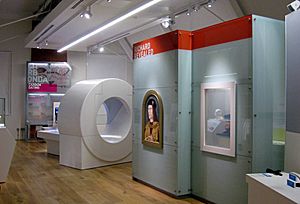
After the discovery, Leicester City Council set up a temporary exhibition about Richard III in the city's medieval guildhall. The council announced it would create a permanent attraction and subsequently spent £850,000 to buy the freehold of St Martin's Place, formerly part of Leicester Grammar School, in Peacock Lane, across the road from the cathedral. The site adjoins the car park where the body was found, and overlies the chancel of Greyfriars Friary Church. It was converted into the £4.5 million King Richard III Visitor Centre, telling the story of Richard's life, death, burial and rediscovery, with artefacts from the dig including Philippa Langley's Wellington boots and the hard hat and high-visibility jacket worn by archaeologist Mathew Morris on the day he found Richard's skeleton. Visitors can see the grave site under a glass floor. The council anticipated that the visitor centre, which opened in July 2014, would attract 100,000 visitors a year.
In Norway, archaeologist Øystein Ekroll hoped that the interest in the discovery of the English king would spill over to Norway. In contrast to England where, with the possible exceptions of Henry I, and Edward V, all the gravesites of English and British monarchs since the 11th century have now been discovered, in Norway about 25 medieval kings are buried in unmarked graves around the country. Ekroll proposed to start with Harald Hardrada, who was probably buried anonymously in Trondheim, beneath what is today a public road. A previous attempt to exhume Harald in 2006 was blocked by the Norwegian Directorate for Cultural Heritage (Riksantikvaren).
Richard Buckley of the University of Leicester Archaeological Services, who said he would "eat his hat" if Richard was discovered, fulfilled his promise by eating a hat-shaped cake baked by a colleague. Buckley later said:
Cutting-edge research has been used in the project and the work has really only just begun. The discoveries, such as the very precise carbon dating and medical evidence, will serve as a benchmark for other studies. And it is, of course, an incredible story. He's a controversial figure; people love the idea he was found under a car park; the whole thing unfolded in the most amazing way. You couldn't make it up.
Some commentators suggested the discovery and subsequent positive exposure and good morale around the city contributed to Leicester City F.C.'s shock Premier League victory in 2016. A few days after the burial, Leicester City began a winning streak to take them from bottom of the league to comfortably avoiding relegation, and they went on to win the league the following year. Mayor Peter Soulsby said:
For too long, people in Leicester have been modest about their achievements and the city they live in. Now – thanks first to the discovery of King Richard III and the Foxes' phenomenal season – it's our time to step into the international limelight.
The two events inspired Michael Morpurgo's 2016 children's book, The Fox and the Ghost King, in which the ghost of Richard III promises to help the football team in return for being released from his car park grave.
Images for kids
See also
 In Spanish: Funeral de Ricardo III de Inglaterra para niños
In Spanish: Funeral de Ricardo III de Inglaterra para niños


